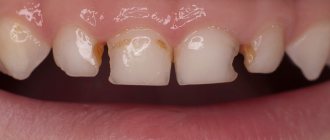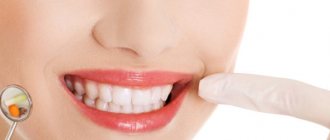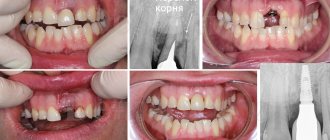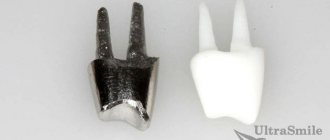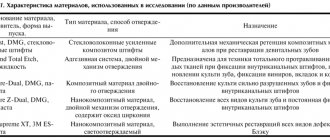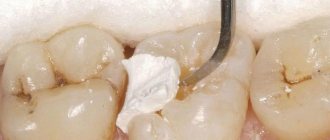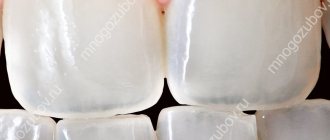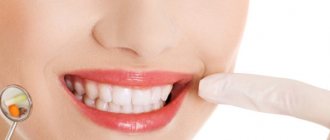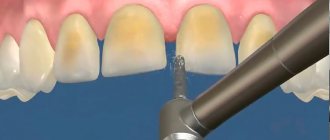In recent decades, therapeutic dentistry has received a significant impetus for development. This is due to the emergence of new materials and working methods, with the help of which it has become possible to restore the crown of a tooth even in the presence of significant defects .
At the same time, it is possible to repeat the smallest individual features of the patient’s dental apparatus. It is thanks to the precise recreation of the anatomical shape of the damaged tooth that structures made of composite materials are harmoniously combined with the environment in the oral cavity.
Restoration of the tooth crown
Indications for restoration
There are quite a few situations that will require you to resort to a restoration procedure. The main reasons include:
- Congenital anomalies of dental development, too wide interdental spaces.
- Minor injuries to hard dental tissues.
- Destruction of enamel as a result of the carious process and other reasons.
Various circumstances can lead to the formation of defects in the hard tissues of the tooth, for example, poor-quality water, lack of vitamins and minerals in food, even improper brushing techniques.
Small defects may not be detected by the person for a long time, which leads to the gradual destruction of increasingly large volumes of enamel and dentin. Therefore, it is necessary to regularly (at least 2 times a year) be examined by a dentist. This will allow restoration of the crown part of the tooth in the early stages and prevent further aggravation of the situation.
Restoration of endodontically treated teeth
Restoration of endodontically treated teeth is a complex procedure, the success of which depends on a significant number of components. Restored teeth must withstand the systemic effects of environmental factors that can provoke the development of crown fractures, displacement of the restoration, microleakage, or even a number of complications requiring the removal of the tooth as a whole. It has been proven that endotreated teeth are at higher risk of developing fractures than vital teeth, especially when it comes to chewing teeth that bear the main chewing load. Endodontic treatment leads to the loss of tooth pulp, that is, its “nutrition” mechanism. For many years it was believed that the problem with fractures of endodontically treated teeth was the weakening of the structure of devitalized dentin, but in the end it turned out that the strength of such dentin is similar to that of vital dentin. In fact, the increased risk of tooth fracture after endodontic treatment is associated with the loss of a significant amount of structural components caused by tooth preparation to create an appropriate endodontic access. Restoring teeth after endointervention through restorations does not allow achieving the initial state of their strength; in addition, the presence of preliminary fillings, carious lesions or chips also negatively affect the prognosis of functioning.
Classification of endodontically treated teeth based on the possibilities of their restoration
The design of the restoration of an endodontically treated tooth depends on the residual amount of hard tissue, the position of the canals relative to each other and the space of the pulp chamber that provides retention. Restoring the crown of a tooth using a pin installed in the root canal increases the risk of developing a root fracture, given that the necessary preparation of the tooth for the pin requires additional reduction of hard tissues. On the other hand, pins make it possible to increase the retention force, and therefore the predictability of the functioning of the restoration. Thus, we can conclude that pins should be used in the least permissible quantity without compromising retention in the area of the restored coronal part of the tooth.
The classification of endodontically treated teeth based on restoration possibilities is based on the number of canals. Thus, class 1 includes teeth with one canal, class 2 – with two, and class 3 – with three or more.
Each class can also be divided into subclasses, taking into account the amount of residual hard tissue: C (presence of almost the entire tooth structure), P (presence of partially preserved tooth structure), N (absence of residual tissue in the coronal part).
The amount of residual dentin is determined by the retained height of the crown and the cross-sectional parameter of its gingival third. The cross-sectional parameter is used in clinical practice because the crown height can be completely preserved, but the wall thickness remains critically minimal.
The existing subclassification can also be interpreted in terms of residual tissues: N – preservation of less than 1/3 of the original dentin volume, P – preservation of 1/3 to 2/3 of the original tissue volume, C – preservation of more than 2/3 of the original tissue volume. For example, class 2P indicates a two-canal tooth with partially preserved volume of hard tissue.
The volume of residual hard tissue in the coronal region determines how much force will be applied to the post, cement and root of the tooth during its functioning. The greater the amount of residual tissue, the less the load on the pin and fixing cement. However, to adequately assess the magnitude of the forces acting on the tooth, and even more so to predict them, is not an easy task. Therefore, during rehabilitation, the doctor must assume that the maximum possible load will be applied to the tooth, and, based on this, model the design of the future restoration.
Clinical case 1
A Class 1N maxillary premolar had previously been restored with a fiberglass post and an all-ceramic crown (Figure 1). After a certain time, under the influence of loads, the pin fractured, as a result of which the crown was also lost. The remaining part of the support was removed from the tooth root, after which the doctor prepared the endospace for the inlay, forming anti-rotation zones (photo 2). Next, a gold inlay was made for this patient using the indirect method (photo 3), onto which a metal-ceramic crown was fixed. The crown was modeled with a bevel in the neck area to provide a ferrule effect and reduce stress on the post (photo 4-5).
Photo 1. X-ray of a premolar after endodontic treatment and restoration with an all-ceramic crown supported on a fiberglass pin.
Photo 2. View after removing the fiberglass pin.
Photo 3. Molded tab.
Photo 4. View of the tab after fixation.
Photo 5. View of the crown after fixation.
Forces acting in the oral cavity
The teeth are subject to forces generated both during chewing and during parafunctional activity. Each of the acting forces is characterized by its own parameters of intensity, frequency, duration and direction. The intensity of the acting force is determined by the magnitude of the action, the frequency by the number of episodes of its application, the duration by the duration of each episode of action, and the direction by the vector of application. Pressure directed strictly upward or downward provokes compressive, tensile or shearing forces on a specific tooth subject to force. The most frequently applied forces may vary in frequency, but are usually stable in intensity and duration. The parameters of frequency, intensity and duration of forces acting on a tooth are quite difficult to objectively determine. The force intensity rating is influenced by aspects of tooth position, muscle size, jaw angle, overall volume of the mouth, diet, habits, general health, and length of time the restoration has been in use. For example, a centrally positioned incisor, when biting on a donut, generates less bite force than the same incisor with a more labially oriented cutting edge. Also, the force of the bite directly depends on the area, cutting or occlusal surface. The angle of the jaw determines the force of the lever, so that in cases with a lower jaw angle, more pronounced forces are generated than in cases with a high angle. Also, chewing teeth can generate a much greater load than the front ones: for example, the second molar provokes pressure 5 times more than the first premolar on the same side of the jaw. Diet also directly affects the level of chewing forces, because chewing soft foods requires less effort. The size of the tooth itself and the condition of the periodontium directly affect the intensity of the forces generated: tooth mobility reduces the level of maximum action, and a 10-fold increase in force during episodes of nocturnal bruxism is associated with loss of proprioception during sleep. The duration of the restoration's functioning is also a good indicator of the level of forces acting in the oral cavity. Long-term use of a large amalgam or composite filling in an area of weakened tooth structure indicates a minimum level of operating loads, because under physiological conditions such restorations would simply chip.
Restoration components
The overall strength of a restoration is determined by the strength of its components and their connecting interfaces. Five components can be used to restore endodontically treated teeth, although not all of them are used in every clinical case. The latter include the tooth itself, the cement, the post, the core and the restoration, which contact at different interfaces. The elasticity of each component is determined by the strength of its material, namely compressive, shear and tensile strength, elastic modulus, fatigue parameters, deformation modulus and thickness. The crown and root of the tooth have a specific predetermined size, which determines the design of all other components used. Moreover, if one of the above-mentioned components increases in size, then the other should, on the contrary, decrease. For example, when the diameter of the pin increases, the doctor must prepare the tooth, which leads to a decrease in the cross-sectional parameters of the root. Thus, the pin becomes stronger, but the tooth as a whole, on the contrary, becomes weaker. Each of the components of the restoration can also be weakened by factors of shrinkage or expansion, the presence of impurities or cracks in the structure, fatigue of the material from which it is made and violation of the required shape. In addition, the interfaces of the constituent components additionally determine the strength of the restoration, because the forces acting on the tooth lead to the separation of elements at the boundary of their connection. Most often, such a mechanism is recorded at the cement-root or cement-post interface. When installing a round pin into a circular root space, rotational forces simply destroy the cement-post and cement-root interface. That is why preparation for a pin should include the formation of anti-rotation zones.
Clinical case 2
The second maxillary class 3N molar required restoration (Figure 6). Four canals were treated in the tooth, and the area of the pulp chamber, as well as the cross-sectional size in the gingival third, were relatively small. First, gutta-percha was removed from the canals using a piezorimer, after which it was prepared with a bur of the same size as the future pin (photo 7). Adhesive treatment was performed using Brush & Bond (Parkell), after which composite cement was placed into the canal using a canal filler. A C-1 type pin was placed in the palatal canal (Figure 8). This type of post is a fiberglass-reinforced composite structure with a level of elasticity similar to dentin, which minimizes stress in the root area. The core was formed using the dual polymerization composite Absolute Dentin (Parkell). For the same purpose, you can use other materials, such as Light-Core (Bisco) light-curing, self-polymerizing Encore (Centrix), or Para Core (Coltene Whaledent), which is an analogue of the dual curing mechanism of a white or dentin shade. After application, the composite used was polymerized for 40 seconds (photo 9). Then we started preparing the stump for the crown (photo 10). The final result of the treatment is shown in photo 11.
Photo 6. Endodontically treated maxillary second molar.
Photo 7. Preparation of the palatal canal for pin fixation.
Photo 8. View after fixing the pin.
Photo 9. Adding material to restore the stump.
Photo 10. Preparing a tooth for a crown.
Photo 11. View of a metal-ceramic crown.
Assessment of tooth structure should be carried out in the coronal and root zones. The coronal part is responsible for the maximum resistance of the tooth as a whole, so it must be preserved to the maximum. The canals and roots differ in their variable structure, but they all taper towards the apex. The use of a conical pin makes it possible to minimize the required level of reduction of dentin tissue, but on the other hand, under such conditions, a wedging effect is formed. The latter can lead to the development of a root fracture. Glass fiber posts, which have the same bending and compression parameters as tooth dentin, minimize the wedging effect, but do not reduce it to a minimum. The use of strictly cylindrical pins provokes the need for additional preparation of the endospace, which increases the risk of root fracture, but reduces the severity of the wedging effect. Providing bonding to tooth dentin in the endospace increases the fixing ability of cement, but achieving success in this manipulation is quite difficult. Firstly, because the cements used for canal filling and temporary fixation may contain eugenol, which inhibits the polymerization of the bond, secondly, the dentinal tubules into which the adhesive must penetrate are already filled with endomaterial, and thirdly , due to the difficulties of controlling moisture in the channel space. In addition, it is difficult to ensure reliable adhesion when the collagen fibers that overlap the dentinal tubules are compressed. Therefore, it is best to hope for a connection with dentin at the mouth of the canal. For post retention and restoration, cements can also be used as a luting material. But they may exhibit shrinkage or expansion during polymerization, causing stress to develop that ultimately results in separation at the joint interface. In addition, some cements can be dissolved by oral fluid. The most popular in dentistry are composite and glass ionomer cements, but in addition to them, hybrid, polycarboxylate and zinc phosphate cements can also be used. It must be remembered that composite cements exhibit shrinkage during curing, while glass ionomer cements, on the contrary, exhibit expansion. Posts used for restorations can be classified according to shape, material, design and method of manufacture. Classic pins are divided into individual and standard. Individual pins and inlays are made from gold or base alloys in a dental laboratory by direct or indirect methods. It is advisable to use such inlay-shaped structures in the absence of the coronal part of the tooth and in the case of significant occlusal forces acting on it. In such cases, the need for additional stump formation is also eliminated. In addition, in the design of the inlays, it is possible to plan the presence of anti-rotation zones, which increase the overall predictability of the functioning of the restoration.
Standard pins can be conical or cylindrical and made of metal, ceramic or fiberglass. Fiberglass posts have become so popular in dentistry because their modulus of elasticity is similar to that of dentin. The same materials that “bend” differently than the tooth’s own tissues provoke the formation of stress in the root structure, increasing the risk of developing a fracture. Standard pins can also be aggressive or passive. Although aggressive pins are characterized by a higher level of retention, they also create more stress points, thereby increasing the risk of fracture. The design of standard posts involves a part of the post that goes inside the root and a part that is located in the crown area. Ideally, the coronal portion should be resistant to rotation and provide adequate retention and space for cement. Improvement of the interface between the pin and the cement can be achieved through the formation of notches and micro-roughness in the area of the coronal part of the pin. At the same time, to install any pin, it is necessary to carry out appropriate preparation of the root canal.
When preparing the root for a cylindrical pin, the diameter of the prepared canal should be slightly larger than the diameter of the pin in order to provide space for cement. Conical pins are more convenient for fixation in the endospace structure. It is equally important to ensure reliable retention of the stump itself to the pin and tooth, and then to the surface of the future restoration. Ideally, the core material should have the same characteristics as the hard tissues of the tooth. After all, if the stump material is too hard, maximum stresses arise in the area of the interface of its connection, but if, on the contrary, it is too soft, the risks of developing microleakage and loss of restoration increase. The retention and resistance of the stump can be increased due to the number of pins, high-quality adhesion to the tooth structure, mechanical retention in the area of the pulp chamber, the wedging effect in the coronal part of the tooth, and the convergence/divergence of the pins, which play the role of intraradicular support.
The goal of restorative treatment of endodontically treated teeth is essentially to close the endospace area and strengthen the weakened tooth structure. Endodontic treatment of anterior teeth does not provoke a significant reduction of their tissues, so covering them with crowns in the future is optional. In the area of distal teeth, the situation is exactly the opposite. Reasoned choice of crown is extremely important to ensure comprehensive rehabilitation success. The presence of a metal neck in the structure of metal-ceramic or all-metal crowns reduces the level of forces acting on the stump. In other words, this provides a ferrule effect, which allows for a more optimized distribution of lateral forces on the neck of the tooth, which, in turn, reduces the level of forces acting on the pin by approximately 30%. This effect cannot be achieved with all-ceramic crowns, so in such cases it is necessary to maximize the support from the residual tooth structure, post, core and luting cement.
Clinical case 3
Class 1C mandibular central incisors after endodontic treatment demonstrated the presence of a sufficient amount of residual tissue (photos 12-13). Restoration of the tooth structure was achieved through only composite restorations (photo 14).
Photo 12. Endodontically treated mandibular incisors, the restoration of which could only be carried out using a composite.
Photo 13. View of access cavities after treatment.
Photo 14. View of the final restoration.
Failures of restorations of endodontically treated teeth
Restoration of teeth subjected to endodontic treatment ensures normalization of the parameters of function and aesthetics of each individual unit of the dentition. Restorations that do not achieve these goals are categorized as unsuccessful. It is especially unpleasant when in the area of endodontically treated teeth there is a catastrophically large fracture of the coronal part or a critically extensive carious lesion. The reasons for clinical failures can also be fractures of not only the coronal part of the tooth, but also the pin or stump, as well as separation of the connection interfaces. Risk factors for tooth fracture after endodontic treatment are excessive reduction of tooth tissue during preparation, excessive stress in the area of the pin during its function, as well as stress occurring directly in the coronal restoration.
Clinical case 4
The patient sought help with an abscess in the area of the right central incisor of the upper jaw. After endodontic treatment, the tooth was restored using a composite restoration. A crown fracture occurred within a week after treatment (photo 15-16). After removing the gutta-percha from the canals, the endospace was prepared for the pin (photo 17). Root adhesive treatment was performed using BRUSH and BOND (Parkell), and post fixation was performed using composite cement (Figure 18). Absolute Dentin was used to form the core (Figure 19). For the same purpose, you can use Ketac-Silver (3M ESPE), Miracle Mix (GC America), and Zenith (Carson Dental). The consistency of Absolute Dentin material allows it to be applied in the most convenient way (photo 20). After polymerization, the defect was restored using a temporary restoration (photo 21), and after some time the crown was fixed (photo 22).
Photo 15. View of a broken tooth after recent treatment.
Photo 16. Visualization of a fracture in the tooth structure.
Photo 17. Preparing the canal for pin fixation.
Photo 18. Fixation of the pin with composite cement.
Photo 19. Adding material for the stump.
Photo 20. The consistency of the material for forming the stump allows it to maintain its position until polymerization.
Photo 21. Preparation of the stump for a crown.
Photo 22. View of an all-ceramic crown fixed on the formed tooth stump.
Conclusion
Restoration of endodontically treated teeth is a complex and complex procedure. To ensure the long-term success of this clinical procedure, the physician must understand the specific forces acting on such a restoration, the interaction of its components with each other, as well as the interfaces of their connection.
Author: Paul R. Chalifoux, DDS
Basic restoration techniques
In modern dentistry, many methods are used to eliminate hard tissue defects. This allows you to apply an individual approach to each patient and choose the most effective ones depending on the condition of the tooth. The most common methods include:
- Filling. The filling materials currently used make it possible to reliably eliminate even large defects and restore not only the chewing function of the tooth, but also the aesthetic appearance of the entire dentition.
- Veneers. These are thin ceramic onlays; they are widely used to correct defects and compensate for wide interdental spaces.
- Crowns. An old but reliable method of restoring teeth. Thanks to the use of new technologies, even very large imperfections (loss of 70% of tissue) can be eliminated with the help of crowns.
- Fiberglass reinforcement. Used to compensate for the loss of one tooth. Its artificial counterpart is built onto a base made of fiberglass threads, which are attached to adjacent teeth. There is no need to sharpen them.
Restoration of the tooth crown
The technology of stump overlays is also widely used.
It consists of inserting a pin into the surviving root. A crown is then installed on it or a composite material is applied layer by layer. The method allows you to restore even a completely lost coronal part, if you managed to save the root.
Veneers, core inlays, pins
For a specific tooth, you can make a kind of prosthesis in the form of an artificial crown. They are made from ceramics or metal ceramics. In other cases, restoration of the tooth crown using filling materials is indicated. This restoration is completed in just one visit to the dentist. But if the crown of the tooth is thoroughly destroyed, it is restored using a stump inlay. They are made from various alloys: precious, silver-palladium, cobalt-chrome alloy. After installing the inlay into the tooth cavity, a crown prepared in advance or an all-ceramic veneer is put on it.
Veneers are fairly thin plate-like coverings that are attached to the front of the tooth. They create an exact imitation of the natural surface of teeth in all respects, except, of course, the material from which they are made. It can be porcelain, ceramics or composite materials.
When installing composite veneers, you should take into account that, despite the fact that they are installed in one visit, they may change color in the future. Therefore, dentists recommend porcelain or ceramic plates, which are more durable and more attractive in appearance, but they are much more expensive. Yes, and you will have to spend more time. It is necessary to take an impression of the teeth so that dental technicians can see a complete match of both jaws. Based on the impression, a suitable structure will be made in the laboratory, which the doctor will then install for the patient.
Another option for restoring a tooth crown is to install an intracanal pin. It is made from hydrocarbon, titanium or fiberglass. This structure will be installed in the dental canal after endodontic treatment has been carried out in it. In order for the pin to stand for a long time and firmly, the top of the tooth must be closed. After that, the tooth crown is restored using the materials used for prosthetics.
Crown extension algorithm
In the process of building a crown using composite materials, it is especially important to accurately replicate the natural anatomical shape of the tooth surface. The chewing surface of molars is particularly complex. It is diamond-shaped and includes four tubercles:
- Paracone.
- Metacone.
- Protoconus.
- Hypocone.
Additional tubercles may also be present, for example, the Karabel tubercle. Between the tubercles there are grooves separating them from each other. The dentist must reproduce all these structures as accurately as possible, using composite materials and special instruments. Due to this, the chewing load will be evenly distributed, which will prevent further tooth decay.
To simplify orientation, a special coordinate system is used, which divides the tooth into four sections:
- Medial.
- Vestibular.
- Distal.
- Palatine.
This division makes it possible to more accurately calculate the pattern of tubercles and grooves on the functional surface of the crown, which significantly facilitates the formation of a new surface.
The restoration algorithm looks like this:
- Cleansing teeth from plaque and other contaminants. Then a material of a suitable color is selected and a local anesthetic is administered. In essence, this is a preparatory stage at which everything necessary for further actions is prepared.
- Tooth preparation. It involves the removal of parts of the crown that are injured or affected by caries. It is performed within the boundaries of healthy tissues that have retained their natural characteristics.
- Application of materials. To imitate dentin and enamel, the same composition is used, differing in color. A darker shade is selected for dentin, and a lighter shade for enamel, corresponding to the color scheme of the remaining teeth.
- Formation of a new chewing surface. It involves the artificial recreation of anatomical structures such as tubercles and grooves. This is a difficult stage, since the quality of the specialist’s entire work largely depends on it. To perform it, you will need to use several types of bur (ovoid, needle-shaped, No. 3, No. 4).
Different burs are needed to repeat the shape of the microrelief of the chewing surface, which will fully correspond to the structure of the lost area. After the process is completed, the crown is polished. To do this, use polishing heads made of silicone or circular brushes with polishing paste.
Restoration of the tooth crown
Polishing significantly improves the smoothness of the crown surface. In addition to additional comfort for the patient, polishing serves as a preventive measure for the development of caries and plaque deposits. It will be much more difficult for food debris and bacteria to attach to a smooth surface.
Dental crowns in our clinic
At OWN PEOPLE dentistry, crowns are selected individually for each patient. Our doctors will take into account all the client’s wishes, including the appearance of the prosthesis. One of the main principles of the clinic is the availability of care. Therefore, when selecting a crown, dentists also focus on the patient’s budget and the cost acceptable to him.
All stages of manufacturing and installation of crowns are controlled by the attending physician. This ensures high quality and long-lasting wear of the prostheses. And after installation, the dentist conducts a detailed consultation on wearing and caring for the crown.
Free consultation!
Our clinic provides free consultations, during which the dentist will determine whether the patient needs a crown and outline a rough treatment plan. You can discuss with him the materials and methods of making prostheses in order to choose the most convenient one. The doctor will also tell you what procedures will have to be completed before installing a crown and what costs the patient should expect.
Features of composite materials used for restoration
There are many different composites that are suitable for restoring the crown of a tooth. These materials are characterized by high strength, durability, are easy to use, and have a moderate cost. This combination of characteristics has made them very popular among both dentists and patients.
The basis of the composite is an organic or modified matrix in which the filler and other components that make up the material are evenly distributed. Inorganic microparticles of different sizes (from 0.01 to 100 μm) are usually used as fillers. Most often these are compounds of barium, aluminum, and silicon dioxide.
In addition to the filler, dyes, stabilizers and other functional additives are added to the composite composition. There are several main types of composite materials:
- Microfilled. Contains many particles of the minimum available size. They have high aesthetic qualities and excellent wear resistance. They are used to work on front teeth and install veneers.
- Macro-filled. They are distinguished by increased strength, but low aesthetics. Large particles create a matte effect and rough texture. Suitable for working with lateral teeth.
- Mixed. Universal compositions that combine the positive qualities of the above varieties of composites. The main disadvantage is that they cannot be used to eliminate cavities.
There are many other types of composite materials, but they are used less frequently, mainly for solving highly specialized problems, for example, keromers, ormokers.
One of the promising modern developments is nanocomposites, which consist of extremely small particles. They have the best performance in all areas. The only drawback of nanocomposites is the high cost associated with the complex and expensive production process, so they cannot be found in all cities; even in Moscow, not all clinics offer such materials to choose from. But over time they will become much more accessible, since this is a new technology that has only recently begun to spread.
Types of dental crowns
Our prices
| Code no. | Name of procedures | Unit of measurement | Cost, rub. |
| 308 | Recovery from significant damage is simple | 1 unit | 3 500,00 |
| 309 | Recovery from significant damage is complex | 1 unit | 4 500,00 |
| 312 | Artistic restoration (front, side teeth) simple | 1 unit | 10 500,00 |
| 316 | Tooth restoration using a fiberglass pin and reinforced composite material (Sonicfil, Luxocor) | 4 500,00 |
* The prices indicated on the website are not a public offer. The exact cost of treatment can only be determined at an appointment with a doctor.
Prices for treatment in Korolev full price list
Share on social media networks:
Article Expert:
Dyshekov Asker Mukhamedovich
Restorator, orthopedist. Treatment of caries and its complications. Dental restoration (restoration) using fiberglass and titanium pins. Aesthetic dentistry (teeth whitening ZOOM). Endodontic treatment of root canals using NI-TI instruments, retreatment of canals, preparation of teeth for orthopedic structures.
Work experience 10 years
Types of artificial crowns
Restoration of the coronal part of a tooth is often performed by installing an artificial crown. This technique is used when the destruction process has affected more than half of the tissues. The most commonly used types of crowns are:
- All metal. They can be stamped or cast; their surface is often coated with decorative plating, for example, gold. Although this method of producing crowns has become significantly outdated, it is still popular. This is due to the affordable price and fairly long service life of such structures.
- Metal-ceramic. They are also made from metal, but the top layer is formed from ceramic materials. This significantly improves the properties of such crowns and increases their aesthetic qualities.
There are also completely ceramic crowns. They are made from porcelain or zirconium ceramics.
Price
We offer an overview of turnkey prices in Moscow clinics for prosthetics:
| Clinic | Address | Price |
| Dentistry Good Crocodile | St. Perovskaya, 16 | From 1800 rub. |
| Dentistry IceDent | St. 10th Parkovaya, 3 | From 3200 rub. |
| Dento Dento-El | St. Sadovaya-Samotechnaya, 13 | From 2700 rub. |
| Dentistry Magic Smile | St. Tvardovskogo, 12 | From 4600 rub. |
Causes of destruction
Even if the rules of hygiene are observed, teeth can be destroyed under the influence of unfavorable factors:
- caries;
- injuries – chips, cracks, fractures;
- unhealthy food - sweets, soda, baked goods;
- metabolic disorders as a result of endocrine pathologies, kidney problems, gastrointestinal tract;
- abrasive cleaning agents and aggressive methods of enamel whitening;
- lack of nutrients necessary for dental health - calcium, phosphorus, fluorine, vitamins, protein;
- long-term use of certain medications;
- living in an environmentally unfavorable area.
In some people, the development of pathologies is caused by genetic abnormalities or disorders of intrauterine development. Teeth also suffer during pregnancy, when the body’s main reserves are spent on the development and nutrition of the fetus.
What are they: materials
Crowns can be made from a wide range of materials. Some of them contain a metal base, others are completely synthetic. The choice of material depends on the purpose of the crown, wearing time, wishes for appearance and financial capabilities of the patient.
Metal ceramics
Crown with a metal frame and ceramic coating. The material is reliable and aesthetically pleasing. But there are several contraindications to metal-ceramic dental crowns:
- gum recession - the denture becomes visible;
- age under 18 years - thin enamel in children, which is why there is a risk of injury to the pulp when grinding the tooth.
For the adult population, metal-ceramic crowns are considered an excellent option for correcting dentition.
Metal composite
The product has a frame made of an alloy of cobalt and chromium, and a photopolymer composite is used for cladding. The crown is formed in a soft state and then hardens under the light of an ultraviolet lamp.
The result is a thin and durable coating. But the photopolymer composite is colored by bright pigments in food and drinks, so the patient will have to limit himself in consuming such products.
Golden
The material, tested by time and many patients, is gold. It is a precious metal, so it is hypoallergenic. Such products are perfect for people with high sensitivity to foreign materials.
Gold is a soft metal, which is why crowns quickly wear out under the pressure of antagonists. But they do not spoil the enamel of healthy teeth.
Zirconium dioxide
The most modern material for making crowns is zirconium dioxide.
| pros | Minuses |
| High strength; | High price. |
| Aesthetics; | |
| Hypoallergenic; | |
| Long service life. |
In terms of the ratio of advantages and disadvantages, this material is the most optimal of all possible. But the high price is not for everyone.
Metal-free
Modern techniques for making crowns make it possible to avoid metals in the composition of the product. This is especially important for those who are allergic to them, and you don’t want to lose aesthetics by installing a gold model.
Ceramic
Ceramic crowns are the most similar to natural teeth. They have a sufficient degree of transparency, and can also be matched in color to match natural enamel.
But such crowns are fragile and fragile. Therefore, they are used for the front teeth, and for the back teeth you will have to choose a different material.
Porcelain
Porcelain crowns are not as popular, but they have many advantages.
| pros | Minuses |
| Anatomical shape; | Fragility; |
| High accuracy; | High price; |
| Comfortable wear; | Loose fit; |
| Strong fixation; | High risk of destruction of adjacent teeth. |
| Minimal risk of loosening; | |
| High aesthetics; | |
| Durability; | |
| No staining; | |
| Resistance to temperature changes; | |
| Hypoallergenic. |
In terms of the ratio of pros and cons, porcelain products win in many respects. But people with thin enamel are not recommended to have them installed due to the risk of damaging healthy teeth.
Combined
Models made from combined materials are suitable for long-term wear. They can be used for teeth with any location: they are aesthetically pleasing for the front ones and can withstand the load of the back ones.
Such products are not without drawbacks. They quickly wear out and wear out, and can become deformed. But this is a fairly budget option for prosthetics.
Plastic
The products are only suitable as a temporary tooth replacement. They are light and comfortable, their production takes little time and does not require a large budget. While the permanent structure is being prepared, you can use plastic crowns, but you won’t be able to wear them for a long time - they simply won’t withstand the load.
If it hurts under the dental crown
Installing a dental crown is a complex operation. Therefore, after it, pain may be observed for 2-3 days. This is a normal reaction of the body to intervention. Therefore, doctors recommend taking painkillers during this period.
If your tooth hurts for a week or more, you should consult a doctor for a second examination. It is possible that a pocket has formed between the gum and the crown where food has entered. This can cause inflammation. In this case, you need to start treatment as early as possible so as not to lose the tooth.
How a tooth crown is made
Before you start making a crown, you need to decide on its shape and size. To do this, do:
- visual inspection;
- overview and targeted x-ray;
- 3D – computer visualization of a model of the jaw and tooth.
Making a crown for a tooth depends on its type, the material used and the production method. An impression of the patient's jaw is taken as a sample. They are sent to the laboratory to create a plaster model. After drying, the master cuts out the desired element and makes a prototype of it from wax.
Then the resulting model is fixed on the base and filled with a specialized mixture. In this state it remains in the oven for 4-5 hours. Then the mold is taken out and, while it is still hot, filled with alloy. Until the moment of hardening, the future artificial tooth remains in such a position so that its deformation does not occur.
Types and methods of making a crown
Products differ not only in service life and materials of manufacture, but also in appearance. The doctor selects the appropriate option during a personal consultation, since an in-person examination of the patient is required.
Bridges
The design is relevant for patients who are missing more than one tooth. In this case, a complex prosthesis is made, the parts of which are connected by a bridge. It is attached to healthy teeth, thus holding crowns. This method is not used for single prosthetics.
Implant supported crowns
If the patient has already installed implants, they can be used as a support for the crown. This will avoid unnecessary stress on healthy teeth and prevent their wear. But if the patient does not have implants, this technique cannot be used.
Crown for one tooth
Most often, patients come with a request to install a crown on one tooth. This is relevant for single destruction from caries or injury. The method of installing a crown is selected based on the condition of the gums, periodontium and bone plates. In some cases, additional operations are required before installing the structure.
Fixation with a pin
A method that is used less frequently than others is placing the crown on a pin. This is a traumatic operation that can cause serious complications. Therefore, they try to abandon this method if alternative methods are available to the patient. If not, the operation is carried out in several stages with constant medical supervision at each of them.
Cast crowns
The most reliable and durable designs are cast crowns. They are made from a single piece of material. The product is highly durable and lasts longer. But this manufacturing technique is not suitable for all materials.
Stamped
To stamp crowns, a dental anvil is used, the processes of which follow the shape of the teeth. To get a stamp, use rubber rings. To make metal crowns, hammers of various sizes and shapes are used. The final form of the prosthesis takes place after processing with special forceps.
Such dentures are cheaper to produce than cast ones. But they are easier to deform and wear out faster. The service life of such prostheses is much shorter.


